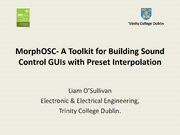
LAC 2013 - Slides: MorphOSC- A Toolkit for Building Sound Control GUIs with Preset Interpolation in Processing PDF
Preview LAC 2013 - Slides: MorphOSC- A Toolkit for Building Sound Control GUIs with Preset Interpolation in Processing
Trinity College Dublin MorphOSC- A Toolkit for Building Sound Control GUIs with Preset Interpolation Liam O’Sullivan Electronic & Electrical Engineering, Trinity College Dublin. Summary • MorphOSC is a new toolkit for building graphical user interfaces for the control of sound using morphing between parameter presets. • Processing class library: – Cross-platform: desktop and Android. – Open-source. • Improved interaction: – Intuitive configuration of parameter spaces. – Layering metaphor for parameter subsets. Presentation Outline 1. Project origins, background, goals. 2. Similar work: software controllers. 3. MorphOSC library implementation. 4. Discussion and future work. Origins and Motivation “Tailoring Multitouch Interfaces for Musical Control” • Graphical User Interface. • Sensor input. • Interaction design. Background: Interactive Music System • Three basic stages linked by a communications protocol. • Processing stage maps the controller inputs to the parameters of output. • Mapping imparts character to an IMS (Drummond, 2009). Simple Mapping • Mapping may be a simple one-to-one arrangement. – Hardware synthesiser: a single control widget (e.g. slider) will control a single sound parameter. – But! A violin doesn’t have a SOLITARY pitch control. Complex Mappings • Type: one-to-many, many-to-one, many-to-many. • Trade-off between initial ease-of-use and potential for expressive play/ long term engagement. • Subjective tests: users prefer complex mappings to simple ones, once learned (Hunt 2000). Violin pitch = (w * finger position) + (w * bow pressure) large small CrossMapper CrossMapper on Android (O’Sullivan & Boland, 2012) Interpolated Parameter Spaces • Parameter space of output (e.g. timbre) is often greater than the available controls, necessitating a few-to-many mapping. • A 2-D controller, for example, can control a high- dimensionality parameter space. – Anchor points represent ‘snapshots’ of parameters. – Can interpolate between anchors for output. – Sacrifices individual control of parameters for intuitiveness/ usability. – Suited to 2-D screen space. Example Interpolation Method • Shepard's Method uses simple inverse distance weighting to interpolate between values of a set of ordered parameters (Shepard, 1968).
